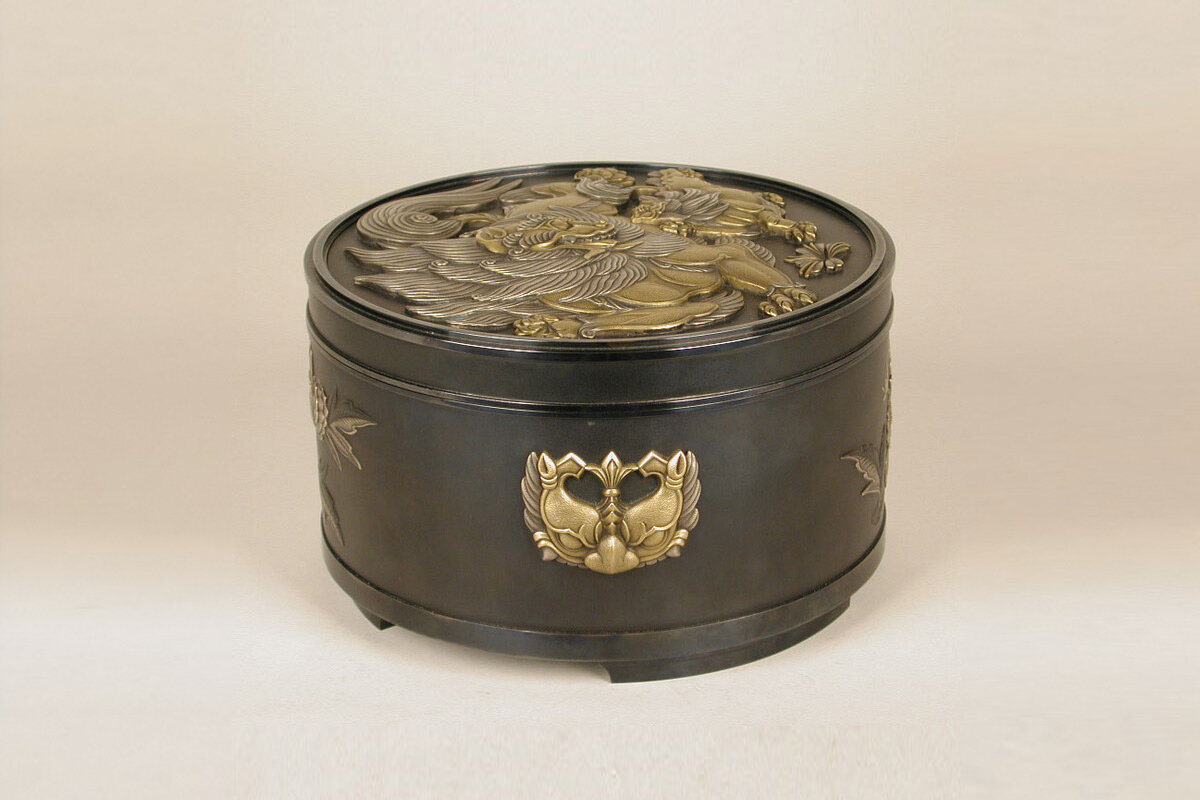ART DECO & MODERNISM
NIHASHI YOSHIHIRA, 1930 TEITEN EXHIBITION, CARVED SHISHI BOX
Marubako or round, lidded box, ornamented on the lid with a design of Oyaku-jishi or a Lion-dog Inspiring his Son; the sides with flowering peonies and stylized masks. The box of cast shakudo carved in deep, marubori technique, with silvered and gilt details; the lid cast and carved of shakudo overlaid with a deeply carved silver block with gilt details; the interior rims of applied silver; and the interior lined in silk brocade. Signed and dated on the reverse with a chiseled signature by the artist: Showa Kanoe Uma Aki, Nihashi Yoshihira Saku or Showa (era) Year of the Horse (1930), in Autumn, Made by Nihashi Yoshihira (Nihashi Yoshihira, the go or art name of Nihashi Rihei, who after 1952 used the go of Nihashi Biko, 1896 – 1977). Showa 5 or 1930.
With the tomobako or original box, inscribed on the exterior of the lid: Kin-iroe Shakudo Shishi Mon Marubako or Gilt Shakudo Lion-dog Design Round Lidded Box; and on the reverse of the lid dated: Showa Kanoe Uma Aki or Showa (era) Year of the Horse (1930), in Autumn, and signed by the artist: Nihashi Yoshihira Saku or Made by Nihashi Yoshihira, and sealed: Yoshihira Saku Han or Made and Sealed by Yoshihira.
Enclosed in the box is the original Teiten exhibition photograph of the box, along with the letter from the Teiten committee awarding the piece the Tokusen (or Gold Prize).
This box was made for exhibition at the Teiten in 1930, where it was awarded the top prize; and it is illustrated in the Nittenshi, volume 9, page 511, number 140.
Nihashi Yoshihira was born in Tenryu City, Shizuoka Prefecture. After graduation from elementary school, he became a student of Unno Bisei. In 1920, he entered the Tokyo School of Fine Arts, graduating in 1925. That same year he was honored with a commission for silver crane ornaments in honor of the Taisho Emperor’s silver wedding anniversary. He began exhibiting at the Teiten in 1929, winning the Tokusen the first year, as well as the second and third times he exhibited.
Employing marubori, one of the most difficult of metalworking techniques, Nihashi Yoshihira carved the ornamentation for this box from blocks of shakudo. After casting the top and sides of the box, he carved the surfaces to leave floral motifs in relief and finely stippled the ground in a refined ishime technique. The mask ornaments were carved from blocks of silver, then gilt and attached to the body with pins. The high relief peony ornamentation was then silvered and gilt. Similar treatment details the lid, with the carved silver shishi plaque then gilt and attached.
Carving metal required far greater skill and work than comparable casting, a fact well-understood by the Teiten judges. Sword smiths developed marubori to ornament sword hilts and tsuba. Very rarely does one see it used for work on a larger scale as here.
For another example of marubori technique, c.f. Kagedo’s catalogue Awaiting the Moon, numbers 146 and 147, which illustrate two kogo or incense boxes carved by Funakoshi Shunmin.
Nihashi Yoshihira, 1930 Teiten Exhibition, Carved Shishi Box
Artist Name: Nihashi Yoshihira
Period: Showa Pre War
Styles: Art Deco, Modernist
Mediums: Metalwork
Form: Ornamental Boxes
Origin Country: Japan
5.25” high x 8” diameter
This piece is no longer available.








